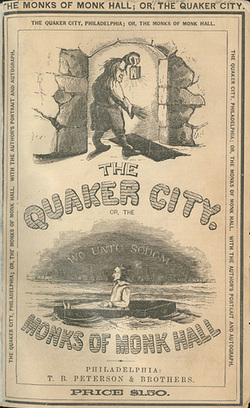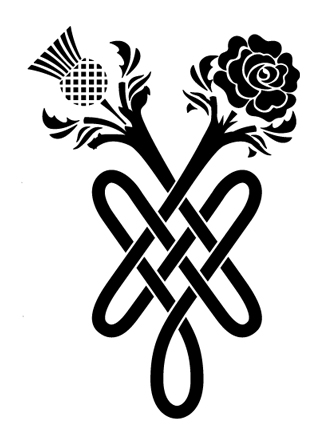
George Lippard’s novel The Quaker City or, The Monks of Monk Hall—published in 1845 and selling over 60,000 copies in the first year alone—is a dark nightmare of a story.
The Quaker City is partly based on the March 1843 New Jersey trial of Singleton Mercer. Mercer was accused of the murder of Mahlon Hutchinson Heberton aboard the Philadelphia-Camden ferry vessel Dido on February 10, 1843. Mercer alleged that Heberton only five days before he shot him had lured his sixteen-year old sister into a brothel and raped her at gunpoint. He entered a plea of insanity and was found not guily. The trial took place only two months after Edgar Allan Poe's short story The Tell-Tale Heart, based on murder trials employing insanity as a defence. Mercer's defence attorney openly acknowledged the object of ridicule which an insanity defence had become. Nonetheless, a verdict of not-guilty was rendered and Mercer’s family were greeted by a cheering crowd while disembarking from the same Philadelphia-Camden ferry line on which the killing took place. Lippard employed the seduction aspect of the trial as a metaphor for the oppression of the helpless.
Devil-Bug, from Quaker City, is one of the most ferocious characters in American literature. He is a loathsome, dwarfish, one-eyed pimp with talon-like fingers, born in a brothel whose ‘soul was like his body, a mass of hideous and distorted energy’.
Excerpt (Devil-Bug speaking):
“It don’t skeer me, I tell ye! For six long years, day and night, it has laid by my side, with its jaw broke and its tongue stickin’ out, and yet I ain’t a bit skeered! There it is now—on my left side, ye mind—in the light of the fire. Ain’t it an ugly corpse? Hey? A reel nasty Christian, I tell ye! Jist look at the knees, drawed up to the chin, jist look at the eyes, hanging out on the cheeks, jist look at the jaw all smashed and broke—look at the big, black tongue, stickin’ from between the teeth—say it ain’t an ugly corpse, will ye?”
On July 12, 1849, a man appeared at the offices, in Philadelphia, of the Quaker City, a newspaper. He was despondent and wearing only one shoe, and was seeking his friend, the editor and writer George Lippard. When he found him he said, “You are my last hope. If you fail me, I can do nothing but die.” Less than two months later he would, in fact, be dead. The man’s name was Edgar Allan Poe.
The Quaker City is partly based on the March 1843 New Jersey trial of Singleton Mercer. Mercer was accused of the murder of Mahlon Hutchinson Heberton aboard the Philadelphia-Camden ferry vessel Dido on February 10, 1843. Mercer alleged that Heberton only five days before he shot him had lured his sixteen-year old sister into a brothel and raped her at gunpoint. He entered a plea of insanity and was found not guily. The trial took place only two months after Edgar Allan Poe's short story The Tell-Tale Heart, based on murder trials employing insanity as a defence. Mercer's defence attorney openly acknowledged the object of ridicule which an insanity defence had become. Nonetheless, a verdict of not-guilty was rendered and Mercer’s family were greeted by a cheering crowd while disembarking from the same Philadelphia-Camden ferry line on which the killing took place. Lippard employed the seduction aspect of the trial as a metaphor for the oppression of the helpless.
Devil-Bug, from Quaker City, is one of the most ferocious characters in American literature. He is a loathsome, dwarfish, one-eyed pimp with talon-like fingers, born in a brothel whose ‘soul was like his body, a mass of hideous and distorted energy’.
Excerpt (Devil-Bug speaking):
“It don’t skeer me, I tell ye! For six long years, day and night, it has laid by my side, with its jaw broke and its tongue stickin’ out, and yet I ain’t a bit skeered! There it is now—on my left side, ye mind—in the light of the fire. Ain’t it an ugly corpse? Hey? A reel nasty Christian, I tell ye! Jist look at the knees, drawed up to the chin, jist look at the eyes, hanging out on the cheeks, jist look at the jaw all smashed and broke—look at the big, black tongue, stickin’ from between the teeth—say it ain’t an ugly corpse, will ye?”
On July 12, 1849, a man appeared at the offices, in Philadelphia, of the Quaker City, a newspaper. He was despondent and wearing only one shoe, and was seeking his friend, the editor and writer George Lippard. When he found him he said, “You are my last hope. If you fail me, I can do nothing but die.” Less than two months later he would, in fact, be dead. The man’s name was Edgar Allan Poe.




 RSS Feed
RSS Feed
